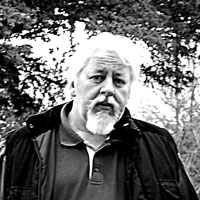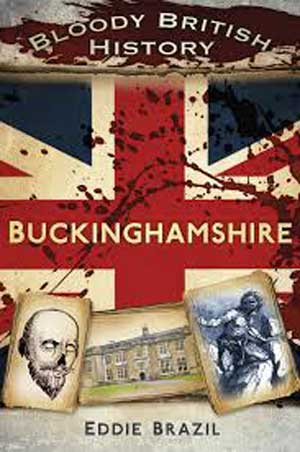EDDIE BRAZIL, author of the newly-released Blood British History: Buckinghamshire, looks into Britain’s past and discovers that her reputation as the haunted islands is undoubtedly linked to the nation’s bloody heritage
The history of Britain has been, in the main, one of relative peace, innovation, triumph and victory interspersed with periods of calamity, catastrophe and bloody murder. We live on an island which, for thousands of years, has been soaked in blood. Is it any wonder that Britain is thought of as the most haunted place on earth? The Spooky Isles!
Yet for one to become a ghost, either of the stone tape variety or those spirits which roam forever the shadowy vale of tears, a person’s demise would apparently have to be not only bloody and traumatic, but in some cases, diabolically preordained.
Anglo Saxons cut off the heads of their wives
Take, for example, the Anglo Saxons. These invaders not only came with fire and sword but also brought new religious ideas for they practised blood sacrifice. Many Saxon graves have been discovered with the remains of mutilated or decapitated skeletons. In numerous burials the headless bodies of women were laid on top of the male corpses suggesting that the spouse of the dead warrior was also ritualistically killed to accompany her husband in to the next world. Other burial sites have revealed that the females were possibly slaves who were viewed as the property of the men and were buried whilst still alive.
We may understand why many women faced with the prospect of prematurely joining their dead spouse opted to be joined in marriage to the horned one and practised witchcraft. It is a common held belief that those found guilty of witchcraft in 16th and 17th century England suffered death by being burned at the stake. Although many witches, mostly women, who were accused of being in league with the devil, were either hanged, drowned, strangled or had their tongues pulled out, between 1440 and 1650 only three were convicted of witchcraft and burnt, and they were first strangled before being set ablaze. Ironically, in England, those who went to the stake were not disciples of satan, but in fact devout followers of Christ. And they were set alight by other equally staunch Christians. It was all over the trifling matter of who could own and read the Bible.
Children were forced to burn father alive
In 1506 William Tylsworth of Amersham was sentenced to be burned to death for owning a Bible printed in English. The savagery of the time demanded that Tylsworth’s daughter, Joan, light the fire herself. Perhaps the most cruel and heartbreaking of the executions was that of John Scrivener. His young children were forced to light their father’s blaze. Others who perished included Thomas Harding who was burned at Chesham in 1532. As the flames licked higher and the poor man writhed in pain, one of the horrified spectators mercifully took pity on the wretched soul and threw a log at him that “dashed out his brains”, sparing him the prolonged agony of his fiery end.
Plague killed half of population
If death, ritualistic or barbaric didn’t get you, then the pesky rat flea would.There was no more deadly or devastating disease known to medieval Britain than bubonic plague. Between 1348-50 it killed almost half the population . There was no cure, and once infected the victim had but days to live; in some instances, hours. It was no discriminator of class, age, health or wealth. The only defence against its merciless spread was flight from ones fellow beings and neighbours in to what isolation one could find.
Its symptoms could be said to have come straight from hell’s infirmary. Once contracted black buboes, some as big as apples, would appear under the arm pits and around the groin. A blackish, gangrenous pustule would form at the point of the infection. Dark blotches appeared on the arms, thighs or other parts of the body caused by hemorrhages under the skin. With the swellings came fever and an agonising thirst. In some case the sufferer would spit blood. The sweat, excrement and breath of the unfortunate victims gave off an overpowering stench.
With almost no medical knowledge of how to defeat the disease, patients were subjected to barbaric means of treatment which included forced vomiting, urinating and bloodletting of the ankles. Some of the sick would be wrapped in a blanket and drenched in cold water. Perhaps the most bizarre and certainly insane remedy was to cut open a live pigeon from breast to back, break open the bird and, while the poor creature was still alive, apply the flesh to the swellings on the skin of the patient. Given such treatments deaths arrival would have seemed like sweet release.
Of course if you survived the plague there was always another way to meet a horrific death; treason.
Being hanged, drawn and quartered was not pretty
On the 30th of January,1606, Buckinghamshire Knight, Sir Everard Digby, for his part in the gun powder plot to blow up King James 1st was dragged on a wattle hurdle to St Paul’s Churchyard in London. There he mounted the scaffold and was stripped of his clothing. Murmuring “Oh Jesus, Jesus, save me“. he was hanged for a short period. Then the executioner cut the rope and Digby fell back to the scaffold wounding his forehead. Fully conscious he was taken to the block, castrated, disembowelled and quartered. Afterwards his severed arms and legs were taken to the four corners of the Kingdom and displayed as a warning to others who might be tempted to travel the republican road. No one knows what became of his genitals.
Up to 90,000 died from chlorea (and others were buried alive)
In the early 19th century the republican road in Britain might well have gained its much needed miles because of the appalling sanitary conditions endured by the poor. From the stinking tenements and hovels stalked the scourge of cholera. Although bubonic plague , once contracted, could carry you off in a matter of hours, cholera was a bit more subtle. At breakfast one could be in the bloom of health. By lunchtime you might feel a bit under the weather. Come the evening you were dancing with the grim reaper and six foot under.
It is estimated that during the worst outbreaks, up to 90,000 people died of cholera in Britain. Those who survived the foul infection were lucky. Even more so were those who were infected, wrongly presumed dead and buried with frightful haste, only to later show the merest flicker of life and be saved from a premature tomb. Yet, we may shudder at the terror and horror of those other unfortunate victims who were thought to have perished, but continued to live. As the coffin lid was hammered down they lay, still conscious, and in the blackness of their wooden tomb, listening as the sound of earth could be heard filing in their grave.
Yet if one could cheat ritualised death, disease or execution there was always the hand of fate which would play the last card.
Murder of children was most foul
In 1943 a family of Jewish evacuees fled London to escape the blitz to the peace and safety of Winslow in Buckinghamshire. One night a Wellington bomber on a routine training flight got in to trouble over the town. As it came down it hit the home of the evacuees killing the entire family.
Yet even more distressing and tragic is the fate of two wartime children. On the 19th November, 1941, six year old Kathleen Trendle and Doreen Hearne, aged eight were on their way home from school in Penn, near High Wycombe when they were offered a ride in an army truck. Both got in, and the truck drove off. The children did not return home that night, and three days later their bodies were discovered in a nearby wood. Both had been strangled and stabbed. Their killer, a 26 year soldier, Harold Hill, was soon caught, tried and executed.
The dreadful incident might never had occurred had the soldier not taken the wrong turn on his return to barracks. He stopped to ask for directions from the children who would not have been there had they not gone back to school to fetch a book.
There is a curious postscript to this appalling murder. On an October night in 1995 A man walking through woods near to where the children were killed heard voices. They were the laughs and shouts of children. The voices seemed to becoming closer but there was no sound of the snapping of twigs or rustle of bushes, only the playful yelps and shouts of two youngsters. The sound of the children seemed to be all around him, but no one was visible. It was at this point that the man became scared and hurriedly moved down through the wood and back to his car. He quickly drove away, his eyes on the illuminated road , expecting at any moment to see two ghostly figures walk out in front of him. Do the ghosts of two children murdered in 1941 still haunt a Buckinghamshire wood?
Bloody Isles. Spooky Isles. Given Britain’s ghastly heritage of violent death, pestilence, war and murder it would seem that both terms are mutually inclusive.
These extracts are from Eddie’s new book,”Bloody British History, Buckinghamshire“, published by History Press.

EDDIE BRAZIL was born in Dublin in 1956. He is a writer, photographer and paranormal investigator. He is co- author, with Paul Adams and Peter Underwood, of The Borley Rectory Companion and Shadows in the Nave: A Guide to the Haunted Churches of England. In 2012, with Paul Adams, he co wrote Extreme Hauntings: Britain’s Most Terrifying Ghosts, and in 2013 he published the first ghostly guide to his hometown Haunted High Wycombe. He has recently completed a bloody history of Buckinghamshire, which will be published in November. He is also a guitarist , and in 1983 wrote the theme music to the British comedy movie,”Expresso Splasho” which featured Gary Oldman and Daniel Peacock. Eddie lives with his wife and Daughter in Hazlemere, Buckinghamshire. Find out more at his website here.


